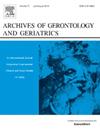Prevalence and prognostic significance of cachexia diagnosed by novel definition for Asian population among Chinese cirrhotic patients
IF 3.8
3区 医学
Q2 GERIATRICS & GERONTOLOGY
引用次数: 0
Abstract
Background & aims
Cachexia is a multifaceted metabolic disorder often linked to chronic illnesses, characterized by substantial weight reduction, inflammatory states, and loss of appetite. The novel diagnostic criteria concerning cachexia established by the Asian Working Group for Cachexia (AWGC) have not been fully validated in Chinese populations with cirrhosis. To assess the prognostic impact of AWGC-defined cachexia among hospitalized cirrhotic patients and explore the synergistic impact of Model for End-Stage Liver Disease 3.0 (MELD 3.0) scores with cachexia status on prognosis.
Methods
We retrospectively analyzed clinical data from patients with decompensated cirrhosis admitted to our tertiary hospital between January 2021 and December 2023. Cachexia was identified according to AWGC criteria, and disease severity was assessed using MELD 3.0 scores. The study's primary outcome was all-cause mortality within one year.
Results
A total of 368 patients were included in the analyses. The prevalence of cachexia was 61.7 %, and patients with cachexia had a significantly higher one-year all-cause mortality rate (26.4 % vs. 7.8 %, P < 0.001). Multivariate Cox regression analysis showed that cachexia (HR 2.68, 95 %CI 1.40–5.13, P = 0.003), along with MELD 3.0 (HR 1.18, 95 %CI 1.13–1.23, P < 0.001), were independent predictors of one-year mortality. The combined assessment of cachexia and MELD 3.0 scores yielded a higher discriminative ability for predicting one-year mortality compared to either metric alone.
Conclusions
AWGC-defined cachexia is a significant prognostic factor in hospitalized patients with cirrhosis. The integration of cachexia with MELD 3.0 scoring enhances prognostic prediction, underscoring the importance to introduce cachexia evaluation during clinical practice for this vulnerable setting.

中国肝硬化患者中亚洲人群新定义诊断恶病质的患病率及预后意义
背景,目的糖尿病是一种多面性代谢紊乱,通常与慢性疾病有关,其特征是体重明显减轻、炎症状态和食欲不振。亚洲恶病质工作组(AWGC)建立的关于恶病质的新诊断标准尚未在中国肝硬化人群中得到充分验证。评估awgc定义的恶病质对住院肝硬化患者预后的影响,探讨终末期肝病模型3.0 (MELD 3.0)评分与恶病质状态对预后的协同影响。方法回顾性分析我院三级医院2021年1月至2023年12月收治的失代偿期肝硬化患者的临床资料。根据AWGC标准确定恶病质,采用MELD 3.0评分评估疾病严重程度。该研究的主要结果是一年内的全因死亡率。结果共纳入368例患者。恶病质的患病率为61.7%,恶病质患者一年的全因死亡率显著增高(26.4% vs. 7.8%, P <;0.001)。多因素Cox回归分析显示恶病质(HR 2.68, 95% CI 1.40 ~ 5.13, P = 0.003)和MELD 3.0 (HR 1.18, 95% CI 1.13 ~ 1.23, P <;0.001),是一年死亡率的独立预测因子。恶病质和MELD 3.0评分的联合评估在预测一年死亡率方面比单独使用任何一种指标都具有更高的判别能力。结论sawgc定义的恶病质是肝硬化住院患者预后的重要因素。恶病质与MELD 3.0评分的结合增强了预后预测,强调了在临床实践中引入恶病质评估的重要性。
本文章由计算机程序翻译,如有差异,请以英文原文为准。
求助全文
约1分钟内获得全文
求助全文
来源期刊
CiteScore
7.30
自引率
5.00%
发文量
198
审稿时长
16 days
期刊介绍:
Archives of Gerontology and Geriatrics provides a medium for the publication of papers from the fields of experimental gerontology and clinical and social geriatrics. The principal aim of the journal is to facilitate the exchange of information between specialists in these three fields of gerontological research. Experimental papers dealing with the basic mechanisms of aging at molecular, cellular, tissue or organ levels will be published.
Clinical papers will be accepted if they provide sufficiently new information or are of fundamental importance for the knowledge of human aging. Purely descriptive clinical papers will be accepted only if the results permit further interpretation. Papers dealing with anti-aging pharmacological preparations in humans are welcome. Papers on the social aspects of geriatrics will be accepted if they are of general interest regarding the epidemiology of aging and the efficiency and working methods of the social organizations for the health care of the elderly.

 求助内容:
求助内容: 应助结果提醒方式:
应助结果提醒方式:


